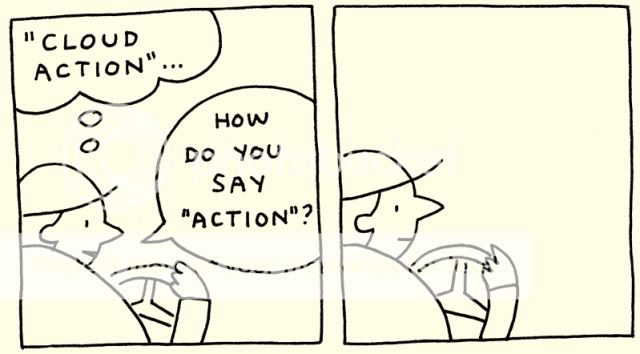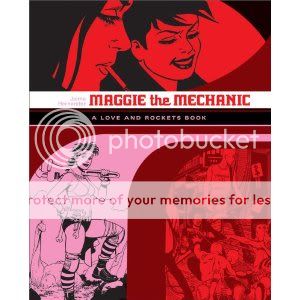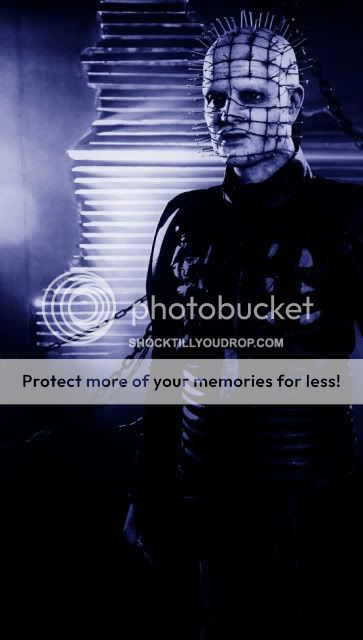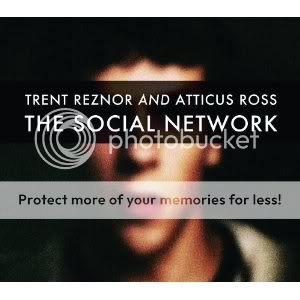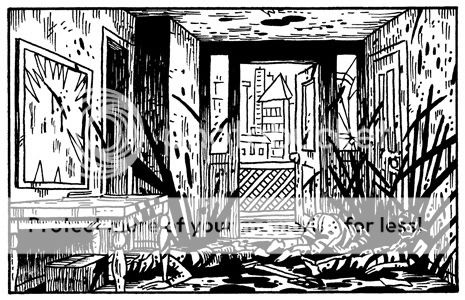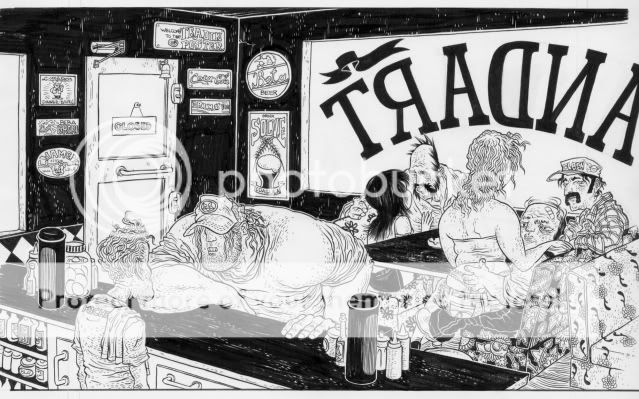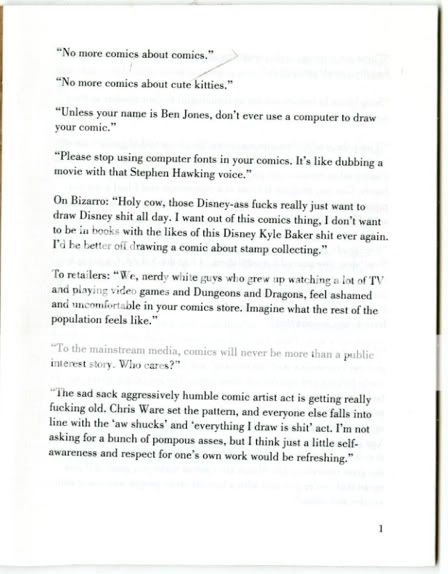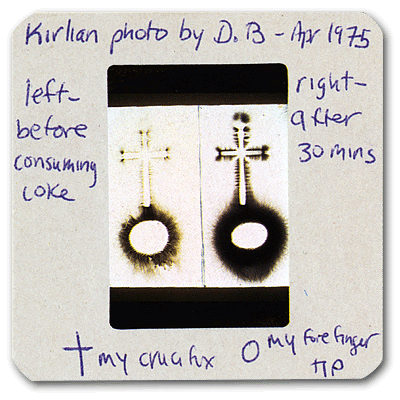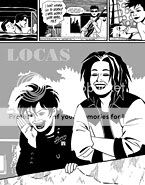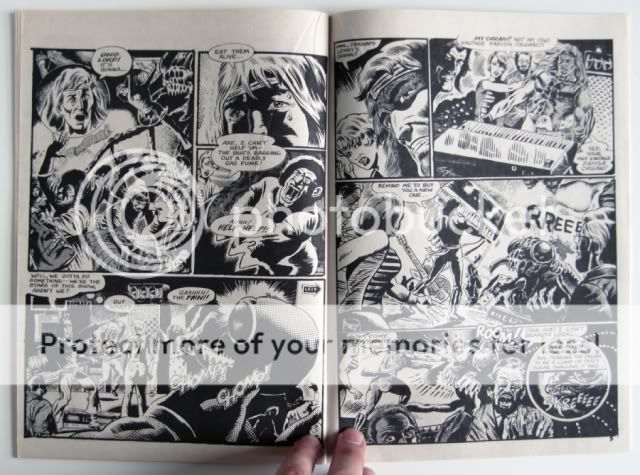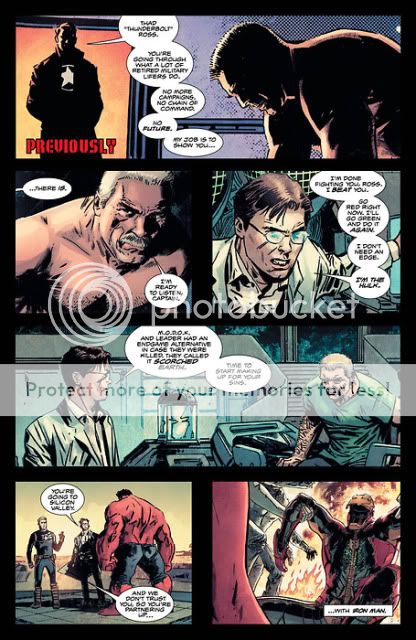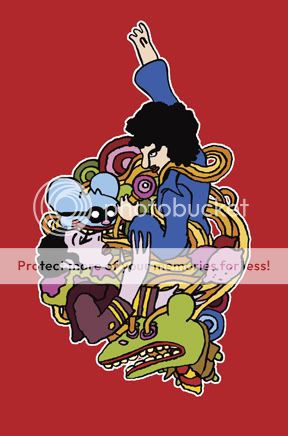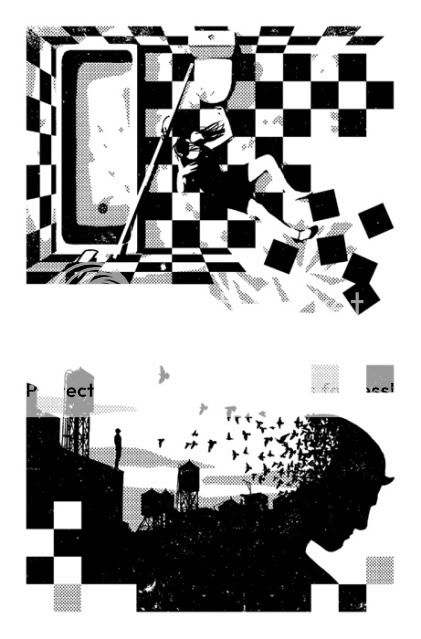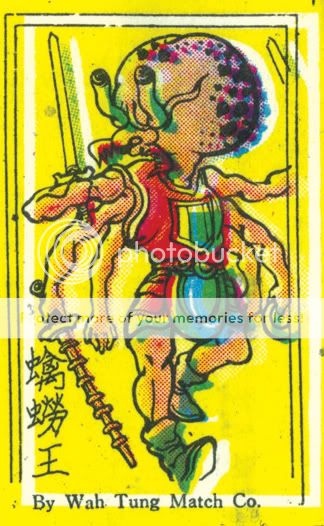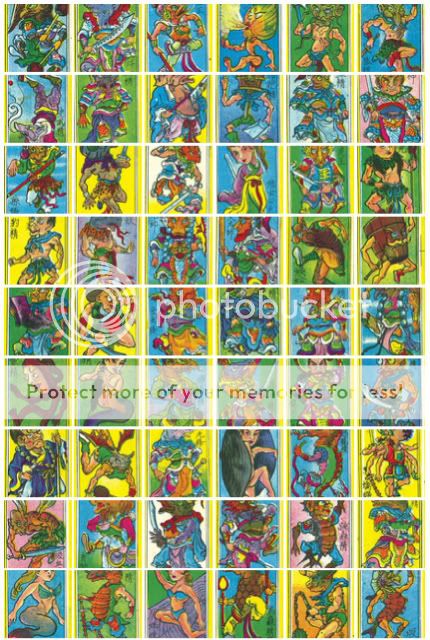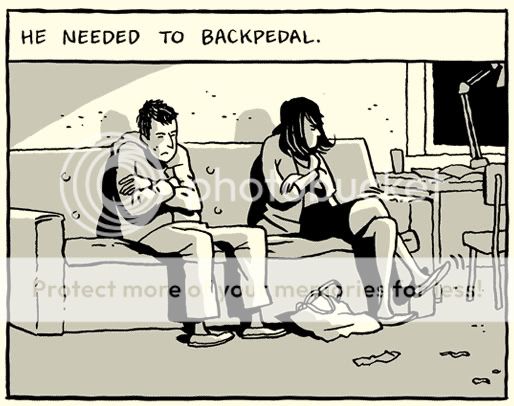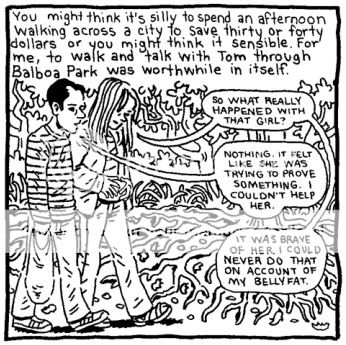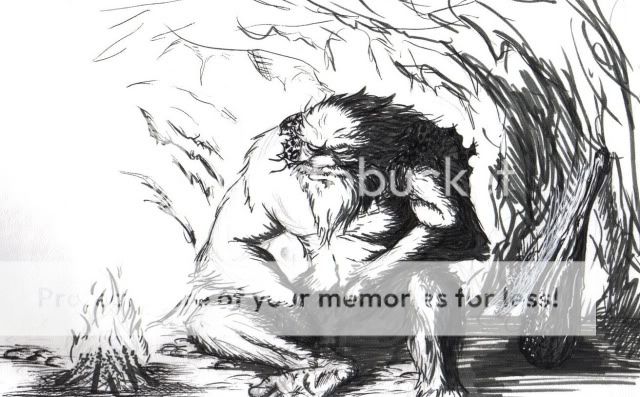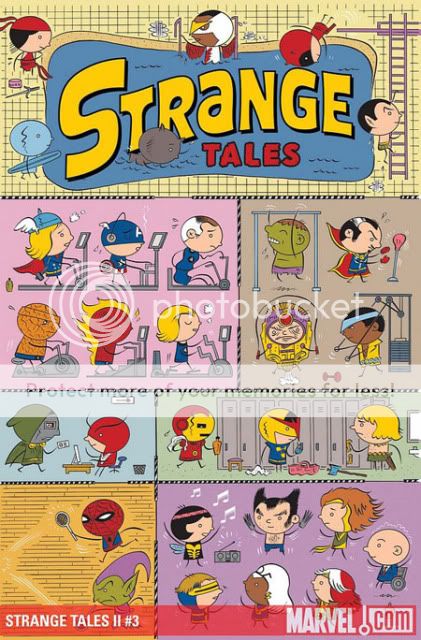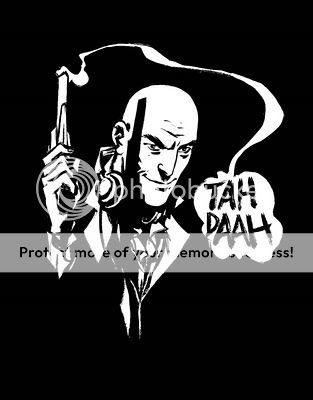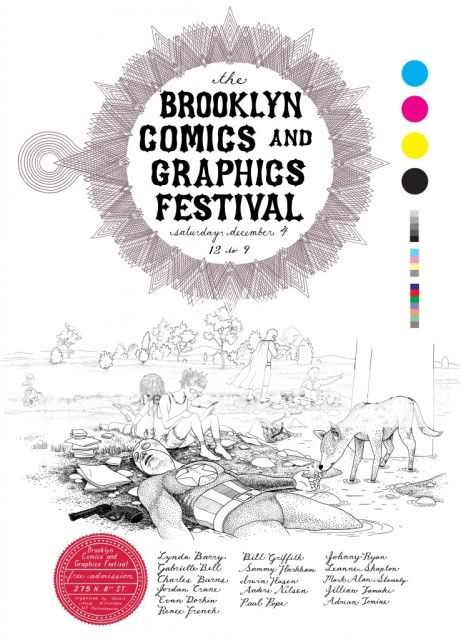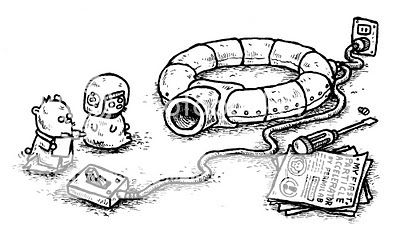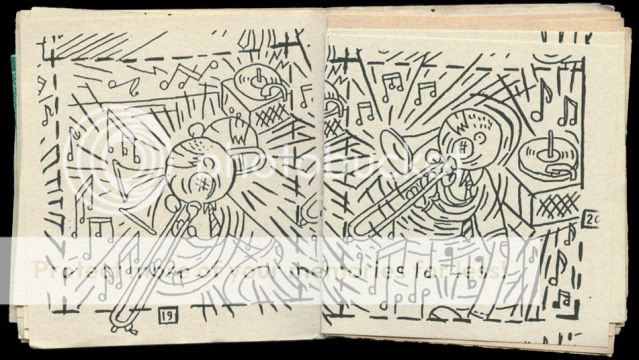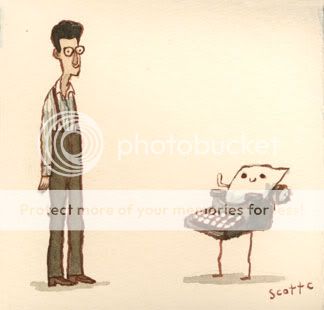NOTE: Back when I worked for Wizard magazine’s website, WizardUniverse.com, I conducted a series of interviews with alternative-comics creators titled I CAN HAS COMIX? That title was a little problematic with some folks at the company — as were the transcription bills — but whaddayagonnado. I kicked the feature off on June 22, 2007 by speaking with Los Bros Hernandez, and I’m reposting the interview here because I think it’s a pretty solid introduction to/overview of the brothers, Love and Rockets, and what I get out of it all.
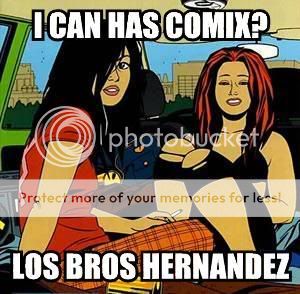
I CAN HAS COMIX?: GILBERT AND JAIME HERNANDEZ
In Wizard Universe’s new alternative comics interview column, Los Bros Hernandez reveal how their shared love of punk rock, sexy girls and Silver Age classics helped their epic series Love and Rockets launch the indie scene as we know it
By Sean T. Collins
I’ll admit that it took me a while to hitch a ride aboard Love and Rockets.
Despite the near-universal acclaim the series and its creators have received over the 25 years since the series’ first issue took the comics world by storm and kick-started a small-press revolution–the fruits of which can be seen at this weekend’s MoCCA Art Festival in New York City–there’s something daunting about it. For starters, it’s not just a straightforward one-man show: It’s an umbrella title for the work of Los Angeles-born brothers named Gilbert and Jaime (and sometimes even older sibling Mario), collectively known as “Los Bros Hernandez.”
What’s more, both Gilbert and Jaime have developed their own mini-mythoi within L&R, featuring enough characters to rival your average superhero universe. In Gilbert’s case, you have the busty, hammer-wielding femme fatale Luba and her friends, lovers, family and enemies, all swirling around the fictional Latin-American town that gives Gilbert’s “Palomar” saga its name. Jaime’s stories center on unlucky-in-love mechanic Maggie and her obnoxious punk-rock best friend/sidekick/sometimes-lover Hopey, wild women who are the stand-out members of a loose-knit group of L.A. ladies dubbed “Locas.” Both casts of characters age in real time, meaning some people who started the series as teenagers now have teenagers of their own, with their own adventures. The warts-and-all presentation of the series’ leads (particularly Jaime’s, in my case) can leave you as pissed of as you’d be at your own obnoxious friends.
And to top it all off, Love and Rockets has spawned two separate ongoing series using that title, a raft of trade paperback collections, two massive hardcovers housing nearly the entire “Locas” and “Palomar” sagas, and countless spinoff miniseries, graphic novels and even adult comix. Put it all together and it’s enough to make the friggin’ Legion of Super-Heroes’ continuity seem easy to follow.
Until now.
To celebrate L&R‘s 25th anniversary, publisher Fantagraphics recently began releasing awesomely affordable, handily portable softcover digest collections, starting at the beginning of both brothers’ epic storylines and giving readers their best chance ever to get in on the ground floor. With the first volumes (Jaime’s Maggie the Mechanic and Gilbert’s Heartbreak Soup) already in stores, the second installments–The Girl from H.O.P.P.E.R.S. by Jaime and Human Diastrophism by Gilbert–launched this week, with some of Los Bros’ best work ever on board.
I could go on about both brothers’ mastery of character development, creating people as flawed, funny, and fascinating as your best friends. I could wax rhapsodic about their sophisticated storytelling, which relies on the readers’ intelligence as it bounces back in forth in time and between dozens of characters. I could point out that at different times, it’s the funniest, raunchiest and scariest comic you’ll ever read. I could talk for ages about the gorgeous art–Jaime’s sharp, sexy, stylish classicism and Gilbert’s earthy, equally sexy surrealism. And I could say that while you hear a lot about “creating a universe” in comics, no one’s ever done it better than Los Bros–when you read an L&R story, you feel like you’re catching just a small glimpse of a world as big, sprawling, messy, funny, horny, heartbreaking and real as our own.
Instead, in this joint interview with Gilbert and Jaime, I’ll let Los Bros themselves explain the inspiration of the series, reveal the dark secrets of the stories in the new digests, and announce their pick for the greatest superhero comic of all time. Through it all, it’s clear that when it comes to creating thrilling uncategorizable comics in Love and Rockets, the brothers are still armed and dangerous.
WIZARD: Take us back to 1981 when you guys started the books. What made you say, “Let’s do this”?
JAIME: Let’s see, 1981…I was being paid to go to junior college, so I didn’t want a job. I was just taking art classes and stuff like that. I wasn’t thinking about what I was going to do with my life–I just liked drawing comics. By that time we were drawing comics for ourselves, but we were starting to draw them with ink on the right paper and everything, not just on a piece of typing paper with a pencil. We wanted to print it somewhere but we didn’t know where, because it wasn’t your normal Marvel or DC fare. There wasn’t really much of a market for this stuff, we thought. We were still punk rockers in bands and we were just doing comics. We wanted to draw comics the way we wanted to see them, and we weren’t really seeing much of them out there.
GILBERT: Comics were our amusement for years, and what we were into was not what the mainstream companies were into at the time. We figured that by printing an underground magazine we would get it out there, mostly to see what the response would be–just something to do, really. It turned out that when we finally got our stuff together and put out a 32-page Love and Rockets comic, a fanzine/underground type thing, we were luckily noticed right away by Fantagraphics. The timing was just right–they were ready to publish their own comics. It took a little climb to get Love and Rockets going, but the response was very good, even in a small way at first, so that encouraged us to continue.
It’s not too often that people in the alternative comics area have that kind of success right out of the gate, but I guess you guys didn’t have a lot to compare it to. Before Love and Rockets there were the undergrounds, but they were sort of a different beast.
GILBERT: Yeah. Cerebus and ElfQuest were actually encouraging in the sense that it could be done, getting a following for a black-and-white comic. It wasn’t necessarily mainstream. Even though they were both geared for that audience, they were successful on their own.
Jaime, you had more “mainstream” elements in your early work, with its sci-fi flavor. Was that an attempt to tap the normal comics-reading audience, or was it just you following your bliss?
JAIME: It was pretty much just me. I liked drawing rockets and robots, as well as girls. [Laughs] It really was no big game plan. It was almost like, “Okay, I’ll give you rockets and robots, but I’ll show you how it’s done. I’m gonna do it, and this is how it’s supposed to be done!” I went in with that kind of attitude.
That’s definitely a punk attitude.
JAIME: Yeah. I’d see something was being done in other comics and I’d say, “Ah, no, no, that is not the way to do it. This is the way to do it.” That gave me encouragement to just do it. In the beginning, I was putting my whole life of drawing comics since I was a kid into this comic. When the characters started to take over, the other stuff started to drop out because it was getting in the way.
And the result was a book that’s been credited with inventing alternative comics as we know them, though that couldn’t have been your intention at the time.
GILBERT: I think that we did create a path, at least, using all our influences and what we saw about comics that we knew of since we were kids. That developed into mainstream comics in the ’60s, and undergrounds in the late ’60s, and then in the ’70s you’d have mainstream companies that would also publish black-and-white magazines–different things bouncing around here and there with a different format. That was encouraging to us as well. I think what happened with Love and Rockets is that since there really weren’t the kind of comics we were doing, that is bringing our mainstream influences into a new kind of comic, a new kind of underground, let’s say. An underground with more going on, hopefully. [Laughs] At least I would like to think so. It basically created a path for everybody to at least get on, not necessarily making it easier, but just [having] something there. It was just a different road to go down, and I think that is what we did somehow.
In each of your main storylines, you’ve both created these big, sprawling, interconnected casts over the years. Is that something that two of you talked over, or did it evolve spontaneously and separately out of what you both were interested in doing?
JAIME: I would say that it just kind of happened as the characters started to write themselves. I think because Gilbert started creating all-out characters, it just seemed like a good idea to me, or something. On my end, I basically just created characters that would fill in the gaps of the story. If I needed someone to say something in the back that was totally unrelated to the characters, I would create a character later on. What started out as a drawing of just somebody, I decided, “Hey, I’ll make that someone’s boyfriend.” While in the beginning they were just there to color up the place, after a while they started to take on lives of their own. That is how the characters started to multiply. What about you, Beto?
GILBERT: It would probably be my mainstream influence, with me. Like in, say, Peanuts: You could follow the strip with Charlie Brown and Linus for a few days, and then it would shift to Lucy and Violet. But you wouldn’t lose what the strip was about; it was because all the characters were so well informed that you are always in the Peanuts world. Even if sometimes it was about Snoopy or Sally Brown or whatever, you were always there. That’s on the high end, but in the middle there would be the Marvel Universe, actually, for me. I always liked what fans complain about now: the fact that they were all interconnected. If you needed something heavy and metallic and electronic, you went to Stark Industries. If you needed power, you went to Reed Richards’ unstable molecules. I always liked the crisscrossing of that. Of course it went into madness eventually [laughs], but at first it was very intriguing to a kid. It was something new for superheroes, that interconnecting. In the Hulk comic you could mention Stark Industries, and Iron Man or Tony Stark was nowhere near it but you knew what they were talking about. That is what I liked about it: that interconnecting, even when stuff is off camera. That is pretty much what inspired me to go ahead and do that with mine. That way, you just have a larger canvas to work from.
That’s a big part of L&R‘s appeal–you get the sense that we are following this handful of characters right now as they do things during the course of their day, but that if we just took that camera and moved over a couple of blocks, you could catch someone else in the middle of what is going on in their lives, too.
GILBERT: Yeah, and another aspect is that is how our family worked as well. That’s something we brought from home. Our family, our cousins, aunts and uncles were all interconnected the same way. That was an influence as well, the family unit.
JAIME: Yeah, it was a big family. Our aunt had six kids and our other aunt had six kids.
Talk a little bit about your main characters. In your case, Jaime, it’s Maggie and Hopey, the stars of The Girl From H.O.P.P.E.R.S., and with Gilbert it’s Luba, the main attraction in Human Diastrophism.
JAIME: Maggie started back in high school, where I wanted to create a character I could put into any type of story I wanted–send her to outer space, back to time, to her grandma’s house. She was just a drawing at first, and I just started to think wherever I go, Maggie goes. It took a while, but I put a lot of my thoughts into her, and that’s why she’s the main character and the stories follow her. I created her friend Hopey out of just wanting a sidekick, and seeing the punk girls in L.A. at the time; that was when I was first going to the punk shows. They just kind of hit off together. My Betty and Veronica, you could look at it that way. Or my Batman and Robin. [Laughs] They just worked. When we did the first issue, that was the first response I got: “I like your girl characters.” I went, “Cool, because I like doing them!” [Laughs] That is basically how that started, and Maggie continues because I know her so well and I can put a lot of stuff into her.
GILBERT: My work around the beginning was similar to Jaime’s: a science fiction, two-girls-hanging-out-type thing. Once Jaime’s came out, the response to it was immediate. I could see how much more defined it was [than mine] and how much potential it had. Jaime had already grabbed it and was working that side of it just fine, so I abandoned my stuff and thought, “What is it I really want to say that’s different?” I just kept going back to the idea of this imaginary Latin-American village [called Palomar]. The more I thought about it and the more I felt it out, the more it seemed right. It was completely different from what Jaime was doing. Even from the beginning I thought that Love and Rockets should be a bigger thing. It shouldn’t be just all the same thing, and since Jaime was taking care of that part of it, then doing something completely different but still on the same page would make Love and Rockets a bigger thing, a bigger work of art. So that’s where the encouragement came from, bouncing off the fact that Jaime’s was done and already the response was good, so all I had to do was fill in the rest. I was a little freer, actually, to do something that might not have been commercially viable. I think that Palomar was a little chancier than doing the girl/rocket stuff at the time.
JAIME: I could tell you that Gilbert’s approach helped me a lot in taking the girls out of the science fiction, to handle stuff more at home. Gilbert was the older brother, anyway, so he really did everything before me, ever since we were little. [Laughs]
GILBERT: What’s very interesting about the science fiction stuff is that the question we get asked the most, at least out loud, is “Where is the rocket? That’s the real Love and Rockets.” Oddly, that’s the smaller segment of the audience–they’re just more vocal. The real audience is the one who followed Maggie and Hopey’s adventures as real girls, so to speak, and the Palomar stories. That is the real Love and Rockets reader. But for some reason we have the most outspoken ones saying, “When are you going to do the rockets? It’s called Love and Rockets!” That’s fine, we love doing rocket stuff, but the real Love and Rockets is what we are famous for.
You mentioned that the audience has changed, and now the less genre-y things are actually more commercially viable. Jaime’s had his work published in The New York Times, your recent collections have gotten major mainstream-publication review acreage–could you ever have seen this coming?
JAIME: I think that for me, it was more a case of, “One of these days, sure, I’d like my character standing next to Charlie Brown and Betty and Veronica and Superman.” But I was just hoping we would be able to continue doing it and hopefully make a major living off of it because I didn’t want to do anything else with my life. It was like, “Oh boy, I can continue!” But “How long is this going to go?” I wasn’t even thinking about it. Twenty-five years later, I’m going, “Wow, a quarter of a century and I’m still allowed to do this?” It’s amazing. I just think back to all the talented people I knew in the past who had to stop because they just couldn’t live off of doing their comics.
GILBERT: The one time I got thrown was when we were getting a lot more attention doing Love and Rockets and people were really accepting what we wanted to do in it. What really threw me was when I got to a point where readers would tell us, “I used to read Batman, but now I read your stuff.” I thought that was really creepy. I’d go, “You mean you’d rather read us than Batman?” Batman, Superman, all that stuff–they were icons when we were growing up. Nobody ever thought somebody would rather read stuff that wasn’t that. It just threw me and was something I never really thought about, that someone might like a different kind of comic outside of the Big Two. For us it was always a note of encouragement: “We just better step up to the plate then. If this is what they are saying about us, if this is what they like about us, then we better be good!” And we’ve done our best to stick to our guns about giving the most honest comic we can–coming from our point of view, of course. But it threw me for a bit. It seemed like we were being scrutinized for a while, like, “Okay, this stuff is getting more attention than The Incredible Hulk, so let’s see what they’re gonna do next.” We were like, “Oops!” The only thing you can do is try to get better. Otherwise you’d crumble if you tried to compromise or change things.
What do you think of the new digest versions of your work?
GILBERT: For me, I just trust our publisher. I don’t have the say of how it is going to be packaged, because I couldn’t tell you how, so I have to trust them a lot. I think it’s great if it’ll just give us shelf space. Don’t colorize it or something like that. [Laughs] But as long as it’s presentable and someone will put it on their shelf, that’s all I can ask for.
Jaime, your latest digest includes “The Death of Speedy” and “Flies on the Ceiling,” two of your best-known–and darkest–stories. How did each of them come about?
JAIME: Back before “The Death of Speedy” and “Flies on the Ceiling,” I did this story about Speedy talking to his friend about his sister Izzy. He mentioned how she was all normal and then she went to Mexico and came back weird. When I wrote that, I didn’t know exactly what happened to her. I got that question every time: “What happened to Izzy in Mexico?” I’d say, “Oh, I’ll tell you one of these days.” But to myself I was saying, “Yeah, when I find out!” [Laughs] It took almost 10 years to write. It all came from that, and it took on many forms and shapes and sizes till I finally did “Flies on the Ceiling.” With “The Death of Speedy,” certain continuity was building up in the drama, and all of this was building up to where I wanted to kill somebody. I wanted someone to die. But it was another one of those things where I thought, “I’ll show you how to have someone die.” I was going to challenge myself and everybody else. Speedy became the guy just because of the way things were going: I wanted to kill a main character, and he was a victim of my plans. [Laughs] It didn’t have to be him, but it ended up being him. Years after that I asked myself, “Should I have ever killed him?” It was just one of those things that he fell victim to.
Do you ever wish you could bring him back to life, Superman-style?
JAIME: That’s the cool thing with Love and Rockets: You can always have flashbacks. It doesn’t mean they come back to life; you just tell a story that happened not to screw with history. Which I get really close to, sometimes, just because it’s tempting. I can always bring Speedy back–just in the past. I don’t want it to become formula. I have to do it right.
Gilbert, in your case, again, it’s fairly dark material, since “Human Diastrophism” is about a serial killer preying upon Palomar. What made you let loose this violence on these characters in this town you created?
GILBERT: There was no direct line, no conscious effort to be that dark. It just sort of came out as the stories were developing. Whatever darkness there was is from my unconscious. I don’t really know what the source, but I just wanted darker stories. I was also tired of the cramped format, doing a few pages an issue; I wanted to do a longer story, and the longer the story is, I feel I have to give more. I was basically doing stories unchecked, throwing everything in that I could. In those days I would write stories thinking, “When I finish this story, if I get hit by a truck the next day, then I’ll be satisfied that this is my last story.” I don’t do that anymore. Now I think, “Oh, that was my first story,” and that works just as well when I work. “This is my first story, I’m just getting started, I’m just learning.” In the old days it was the other way around: “Okay, if I’m done with the story then I’m done, but I better get down to business.” I wanted to do the world in a microcosm that had death and rebirth. Everything that you can imagine in an epic story, I tried to stick it in one big story. Like Jaime’s story, I chose a character because whenever you are dealing with a story that big and that universal, the characters that you hurt the most have to be ones you care about, unfortunately. You can’t just make up a character and kill them, because it doesn’t matter. If it’s a character that the readers cared for to a degree, that’s what gives the story more resonance, especially in a large story like that. We don’t really do it to shock or anything, but it’s just part of life.
That is what I was going for with that. And once I was done with it and it did get very good response, then what do you do after that? You just start all over and do your damnedest not to cheapen the story. You try not to refer too much to that story, unless it’s little things you need that you left out or something. Jaime and I are clever enough to bring back those characters in a legitimate way, without cheapening it. In Jaime’s “The Death of Speedy,” you never really see what happened–it could have been somebody else and not Speedy who was killed. There’s that little twist that you can do and make it convincing. The same with Tonantzin setting herself on fire in my story. I could very well say it wasn’t her, it was a set-up. I’m just saying that we’re able to do stories where we can make it work–we’re just not going to. It’s too easy, it’s too pat, and it just cheapens the earlier story.
The characters in both the “Locas” and “Palomar” stories aren’t like the ones in Peanuts or in Riverdale High or in the Marvel Universe–they age in real time. Why’d you make that choice, and do you ever regret it?
JAIME: First of all, it was Gilbert’s idea to actually age them. I’ll let him explain.
GILBERT: I was thinking of a sprawling epic that took years to complete. I think I aged them too quickly for my taste now. I definitely regret that it was a little too quick compared to how long we have been doing it. We’ve been doing it for 25 years and that is not really too quick, but it is in terms of comics because I’m still doing them. I’m not done with the characters that are getting older. What happens is you get the “Tiny Yokum syndrome”: The old strip Li’l Abner was about a bachelor who was being chased by a lovely woman, [and eventually] they married and had a kid. Well, now Li’l Abner is responsible. He can no longer have wacky, nutty adventures because he’s married and has a kid. He has to stay home and take care of the family. What they did was create a character, his little brother, named Tiny. Basically, Tiny had the adventures that Li’l Abner could no longer have–but we don’t know Tiny, we know Li’l Abner. The problem that happened with aging my characters too quickly is that I had to come up with characters to replace the older characters, and it’s not as good. I’ve had several characters to replace my main character Luba, but none of them are Luba. That presents itself in that way, even though some readers probably don’t even know who Luba is because they only read the new ones. That’s fine, but it’s something I regret a little bit, and I keep pushing the main characters back.
Jaime, earlier you compared Maggie and Hopey to Betty and Veronica, but in this case there’s no Archie. Both of you focus on female characters. Was that a conscious choice? Did you just like drawing girls or did you really think you had something to say about women?
JAIME: I think it all started when I was a budding teenager and Gilbert was a teenager, and he said, “Jaime, you should start drawing girls.” And I went, “No, I can’t do that–Mom will kill me!” And he just goes, ‘No, it’s cool,” because he was drawing girls left and right. I started and I thought, “Oh God, I can’t draw girls–[mine] are so terrible!” Then after a while you couldn’t stop me. It all started from wanting and liking to draw women. They are much more fun than drawing men. I thought, you can have your cake and eat it too if you do your comic starring the women instead of the men. You can have men, but you get a lot more done if you are drawing a character you like. At the same time, it’s something Gilbert talked about earlier: When I was young, I always felt that if I was going to put something in my comics, I had to back it up. I had to step to the plate and be responsible. So there was always talk about T&A–“You just like women as objects” and stuff. I was like, “No I don’t–look!” So I started making them characters. I thought, “That’s easy! Just do it! I don’t have to feel responsible to create 10-hundred male superheroes to 10 female superheroes–I can just concentrate on the female superheroes!” That’s how it started for me. Gilbert was well on his way before me, being the older guy. I just followed along.
GILBERT: A lot of Love and Rockets is just simply what we wanted to do, even superficially–if we feel like drawing a person wearing these clothes, doing this thing, just because we feel like drawing that. Most of the time it’s a woman doing it. Then we started giving the characters personalities, like Jaime said, having our cake and eating it too. There was a weird little rub there because we kept getting asked, “Why are you doing women?” Just the fact we were asked that all the time, it was like, “Something is wrong here if you have to ask us why. Why do anything? Do people ask Frank Miller why his stories are so violent?” People are fine with violence but they’re nervous about women for some reason. So we are always up to the challenge. We stick our elbows up and go, “Look, we’re gonna do this and we’re gonna do it as best we can.” We kept getting encouraged–the more we did it, the more good response we got. Then every once in a while, “Why do you do women?” and I thought, “It is really a boys’ club out there, isn’t it?”
JAIME: It was almost like the more they told us not to, the more we did it. It was like, “I don’t see anything I’m doing wrong here. What am I afraid of?”
Who do you consider your peers? What other comics out there interest you?
JAIME: It’s harder for me to say now, because I’ve gotten so locked in this Love and Rockets world of mine, creating my stories and not looking at anyone around me, so I don’t know. I guess it’s competition on the shelves: “Who’s taking up my shelf space?” That’s how it is [now]. When Gilbert and I started out, it was like we were welcomed by the mainstream when the comic first came out, but we didn’t have the heart to tell most of the mainstream, “We don’t want to do what you guys are doing.” I didn’t want to be an assh— about it or anything–we were getting all this support–but we thought, “Oh, so you’re gonna do Secret Wars? After we talked about how there’s a new comics world, you’re gonna go back and do that? Well, fine, you do that, but don’t ask me why I’m not.” It wasn’t till more alternatives and people with their own goofy comics like ours started popping out that we started to get these peers coming out of the woodwork. I would say when the Peter Bagges and the Dan Clowes started coming out too, we kind of formed this little… I don’t want to say club, because everyone lived in a different state. [Laughs] But we liked seeing each other at conventions and events like that.
GILBERT: Were you talking about peers now?
That would be the follow-up. Are you also “head-down,” like Jaime?
GILBERT: I am, pretty much. I’m just so focused on getting work out that I look for influences and for other things to inspire me, [and] rarely is that another comic book these days. One reason is that alternative comics, as far as series go, are barely there anymore. Love and Rockets is one of the few that comes out on a relatively regular basis that continues this old tradition that is pretty much gone now. It’s mostly graphic novels and online comics. It’s just different, and a different way to get ahold of comics. The alternative comics they call pamphlets now are simply not around like they were. I don’t look at comics on the Internet. I don’t really look at the Internet too much. I’m focused on writing the best comics I can, and that takes up most of our lives, really. I don’t want to dis anybody or ignore anyone–I’m just not really focused on things outside at this time.
JAIME: I find that when I go to a comic store I leave with an old Marvel or DC archive 99 percent of the time.
It is kind of a golden age for that stuff. The sheer volume of old stuff that is coming into print in really nice books is amazing.
JAIME: Gilbert told me recently that they did the complete [Steve] Ditko Amazing Spider-Man, and I’m just achin’ to go and get that.
GILBERT: Actually, that just came out, and here is a plug for Marvel. I think that now that that’s collected, the Ditko-[Stan] Lee Spider-Man, I think we finally have a book to show and put down and say, “This, for me, is the best superhero comic ever right here.” There has been stuff that has been pretty close, like [Will Eisner’s] The Spirit and [C.C. Beck’s] Captain Marvel and other things, but this, to me, is the grail of superheroes. It’s great to have it in a package like that. Which means I have to rebuy it. [Laughs] I’ve bought that stuff so many times now in different formats.
JAIME: So this is what we’re influenced by, see? [Laughs] We have nothing to show about the new stuff–this is all stuff we liked when we were kids.
What does Love and Rockets have that would appeal to the kinds of readers who haven’t said yet, “I used to read Batman, but now I read you guys?”
JAIME: It’s more difficult these days, because there are more ways of getting ahold of comics with the Internet and different things now. I think what hooked people, the mainstream readers, from reading Batman or Superman and went to Love and Rockets is that [we] were serialized at the time. New stories about Maggie and Hopey were continued from issue to issue, new stories about Palomar continued from issue to issue. The reader could identify with that, reading a serialized adventure that was similar, superficially, to reading a Batman comic. Now Love and Rockets is different, a little more fragmented, a little more experimental, a little more idiosyncratic, I think. It’s different from how mainstream comics are read now. I get a bunch of free [mainstream] comics every month, and I look at them, and you got to be really into them to know what’s going on. You have to be a fan of that particular book to know what is going on. It’s a different day now, a different way to look at comics now, so it’s probably not as easy to grab that audience these days.
I know when I started getting into you guys it was difficult because of the array of formats and editions that were out there: You had the ongoing series, the trades, the spinoffs…But I feel like now, with the digests, it’s nice and easy. In the same way that now a lot of the superhero comic book companies are collecting the complete Lee-Ditko Spider-Man and all these big giant historical runs of series in these easy-to-follow collections, it’s now a better time than ever to get in on the ground floor of Love and Rockets and start from the beginning pretty easily and affordably. I’ve seen it happen around the office–those digests spread like wildfire.
JAIME: I imagine that is what is going to happen with reprinting this old stuff. It’s sort of like seeing 11-year-old kids with Ramones shirts now–three of the main Ramones are dead. [Laughs] Their music is over 30 years old now, and 11-year-olds are into the Ramones! So you never know. There could be a Lee-Ditko Spider-Man comeback with kids. Who knows?
GILBERT: I met an 8-year-old kid a couple of years ago whose mom kept badgering him: “This guy draws comics! Tell him who your favorite Spider-Man artist is!” And the kid, under his breath, goes, “Ditko.” I was like, yes! [Laughs]
JAIME: Ditko quit in ’67, so it was a long time ago. It’s kind of cool, things being in perpetual print.
Any closing words of wisdom?
GILBERT [in mock-pretentious voice]: We’re not only mainstream geeks here– we’re actually progressive artists. [Laughs] I’m kidding. I don’t know about the progressive part and I don’t know about the artist part. [Laughs] We’re going to continue doing Love and Rockets projects that strike our fancy. And I have a couple of other books coming out. One will be a Dark Horse miniseries which will eventually become a graphic novel called Speak of the Devil–that’s in stores this July. I have another graphic novel coming out in June called Chance in Hell, and that’s my first actual graphic novel with Fantagraphics. It’s in the digest size–not quite as small as manga, but around that size. Hopefully, the casual reader will be like, “Hey, there’s a small book–it must be manga!” [Laughs] That could help!




